
A carpet is a textile floor covering typically consisting of an upper layer of pile attached to a backing. The pile was traditionally made from wool, but since the 20th century synthetic fibers such as polypropylene, nylon, or polyester have often been used, as these fibers are less expensive than wool. The pile usually consists of twisted tufts that are typically heat-treated to maintain their structure. The term carpet is often used in a similar context to the term rug, but rugs are typically considered to be smaller than a room and not attached to the floor.

Kente refers to a Ghanaian textile, made of handwoven cloth, strips of silk and cotton. Historically the fabric was worn in a toga-like fashion by royalty among ethnic groups such as the Ashanti and Ewe. It is also worn by queens, princesses and women of Dagbon. In modern day Ghana, the wearing of kente cloth has become widespread to commemorate special occasions, with highly sought-after kente brands led by master weavers.
Ikat is a dyeing technique originating from Indonesia used to pattern textiles that employs resist dyeing on the yarns prior to dyeing and weaving the fabric.
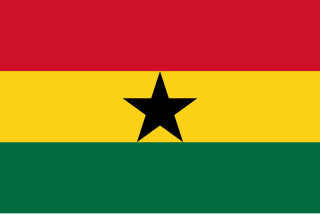
Ghana is a country of 28.21 million people and many native groups, such as:

The Akan people live primarily in present-day Ghana and Ivory Coast in West Africa. The Akan language are a group of dialects within the Central Tano branch of the Potou–Tano subfamily of the Niger–Congo family. Subgroups of the Akan people include: the Agona, Akuapem, Akwamu, Akyem, Ashanti, Bono, Fante, Kwahu, Wassa, and Ahanta. The Akan subgroups all have cultural attributes in common; most notably the tracing of matrilineal descent, inheritance of property, and succession to high political office.

The Ashanti Region is located in southern part of Ghana and it is the third largest of 16 administrative regions, occupying a total land surface of 24,389 km2 (9,417 sq mi) or 10.2 percent of the total land area of Ghana. In terms of population, however, it is the most populated region with a population of 4,780,380 according to the 2011 census, accounting for 19.4% of Ghana's total population. The Ashanti Region is known for its major gold bar and cocoa production. The largest city and regional capital is Kumasi.
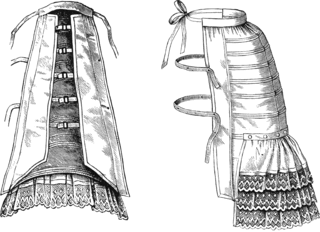
Dimity was a collective term for figured cloths of harness loom decorated with designs and patterns. It was a strong cotton cloth with various stripes and illustrations. It was only bleached or washed after loom less often dyed after looming, unlike fustian, usually dyed.

Gyaman was a medieval Akan people state, located in what is now the Bono region of Ghana and Ivory Coast. Gyaman was founded by the Bono people, a branch of the Akan, in the late 15th century. The Bono then proceeded to conquer the Kulangos, Nafanas, Ligbis, and other ethnic groups of the area.
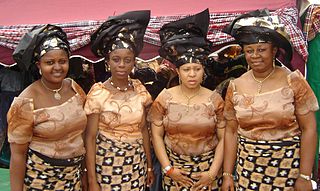
The wrapper, lappa, or pagne is a colorful garment widely worn in West Africa by both men and women. It has formal and informal versions and varies from simple draped clothing to fully tailored ensembles. The formality of the wrapper depends on the fabric used to create or design it.

Adinkra are symbols from Ghana that represent concepts or aphorisms. Adinkra are used extensively in fabrics, logos and pottery. They are incorporated into walls and other architectural features. Adinkra symbols appear on some traditional Akan goldweights. The symbols are also carved on stools for domestic and ritual use. Tourism has led to new departures in the use of the symbols in items such as T-shirts and jewellery.
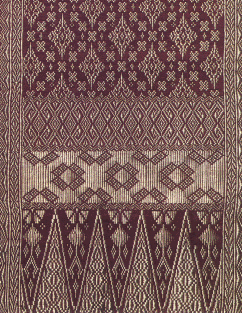
Songket is a Tenun fabric that belongs to the brocade family of textiles of Brunei, Indonesia, Malaysia and Singapore. It is hand-woven in silk or cotton, and intricately patterned with gold or silver threads. The metallic threads stand out against the background cloth to create a shimmering effect. In the weaving process the metallic threads are inserted in between the silk or cotton weft (latitudinal) threads in a technique called supplementary weft weaving technique.
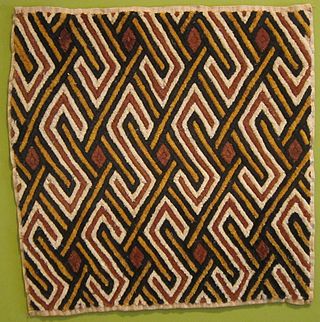
African textiles are textiles from various locations across the African continent. Across Africa, there are many distinctive styles, techniques, dyeing methods, and decorative and functional purposes. These textiles hold cultural significance and also have significance as historical documents of African design.

Samite was a luxurious and heavy silk fabric worn in the Middle Ages, of a twill-type weave, often including gold or silver thread. The word was derived from Old French samit, from medieval Latin samitum, examitum deriving from the Byzantine Greek ἑξάμιτον hexamiton "six threads", usually interpreted as indicating the use of six yarns in the warp. Samite is still used in ecclesiastical robes, vestments, ornamental fabrics, and interior decoration.

Bonwire is a town in Ghana, where the most popular cloth in Africa, popularly known as "Kente", originated. The Kente is worn by the king of the Ashanti Kingdom in Ghana. Bonwire is part of Ejisu-Juaben Municipal district within Ghana's Ashanti Region. The town is located about 18 km on the Kumasi-Mampong road.
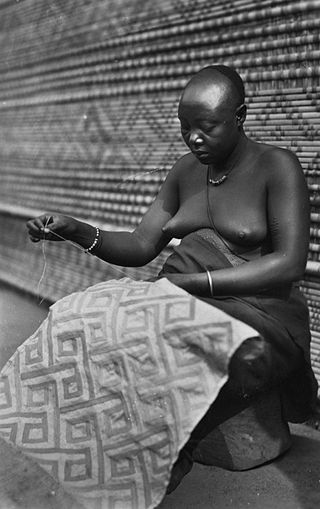
Kuba textiles are a type of raffia cloth unique to the Democratic Republic of the Congo, formerly Zaire, and noted for their elaboration and complexity of design and surface decoration. Most textiles are a variation on rectangular or square pieces of woven palm leaf fiber enhanced by geometric designs executed in linear embroidery and other stitches, which are cut to form pile surfaces resembling velvet. Traditionally, men weave the raffia cloth, and women are responsible for transforming it into various forms of textiles, including ceremonial skirts, ‘velvet’ tribute cloths, headdresses and basketry.
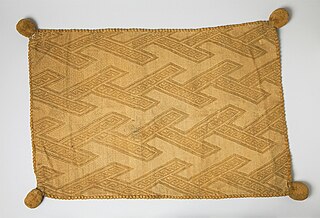
In the Kongo Kingdom and its vassals, the woven arts were emblematic of kingship and nobility. The coarse filament stripped from the fronds of the raffia palm tree served as the foundation of the Kongo weaving arts. This material imposed constraints that were overcome to produce varied and ingenious textile formats and structures. Raffia cloth was used as currency.

Seven Spools of Thread: A Kwanzaa Story is a picture book published in 2000 and written by Angela Shelf Medearis with illustrations by Daniel Minter. The book tells the story of seven Ashanti brothers who must learn to work together, while also demonstrating the seven principles of Kwanzaa.
Malagasy weaving flourished until around 1950. Due to varied ecology in Madagascar, many different materials were used to weave with and formed various styles of mainly striped cloth.

The Kente Festival is an annual harvest festival celebrated by the chiefs and peoples of Bonwire in the Ejisu-Juaben district in the Ashanti region of Ghana. It is usually celebrated in the month of January. Others also claim it is celebrated in July or August.
The Agbamevo Festival is an annual festival celebrated by the chiefs and people of Agotime Traditional Area. It is located some kilometers east of Ho in the Volta Region of Ghana. It is usually celebrated in the month of August. They are Ga-Adangbes. The word Agbamevo means 'loom-cloth' in the Ewe Language.

















